Wheat and rye sourdough bread (no-knead and easy)

Delicious bread baked in a pot with a crispy crust. Just cut a slice, spread with butter and you'll be in heaven!
This is a versatile no-knead everyday bread that we love and make all the time in our house. Making this sourdough bread may seem a bit tricky and there are quite a lot of steps in the process, but it's just not THAT complicated at all! You just have to have enough time because you need to prepare levain the night before.
In the process of making this bread, we will use the STRETCH & FOLD technique. This is a process in which the gluten is activated and the dough gets its elasticity and after that it holds its shape during baking. But this technique of stretching and folding is quite fun and once you get used to it, you will always look forward to this part! In fact, it's really satisfying to watch how an awkward ball of dough becomes firm and elastic.
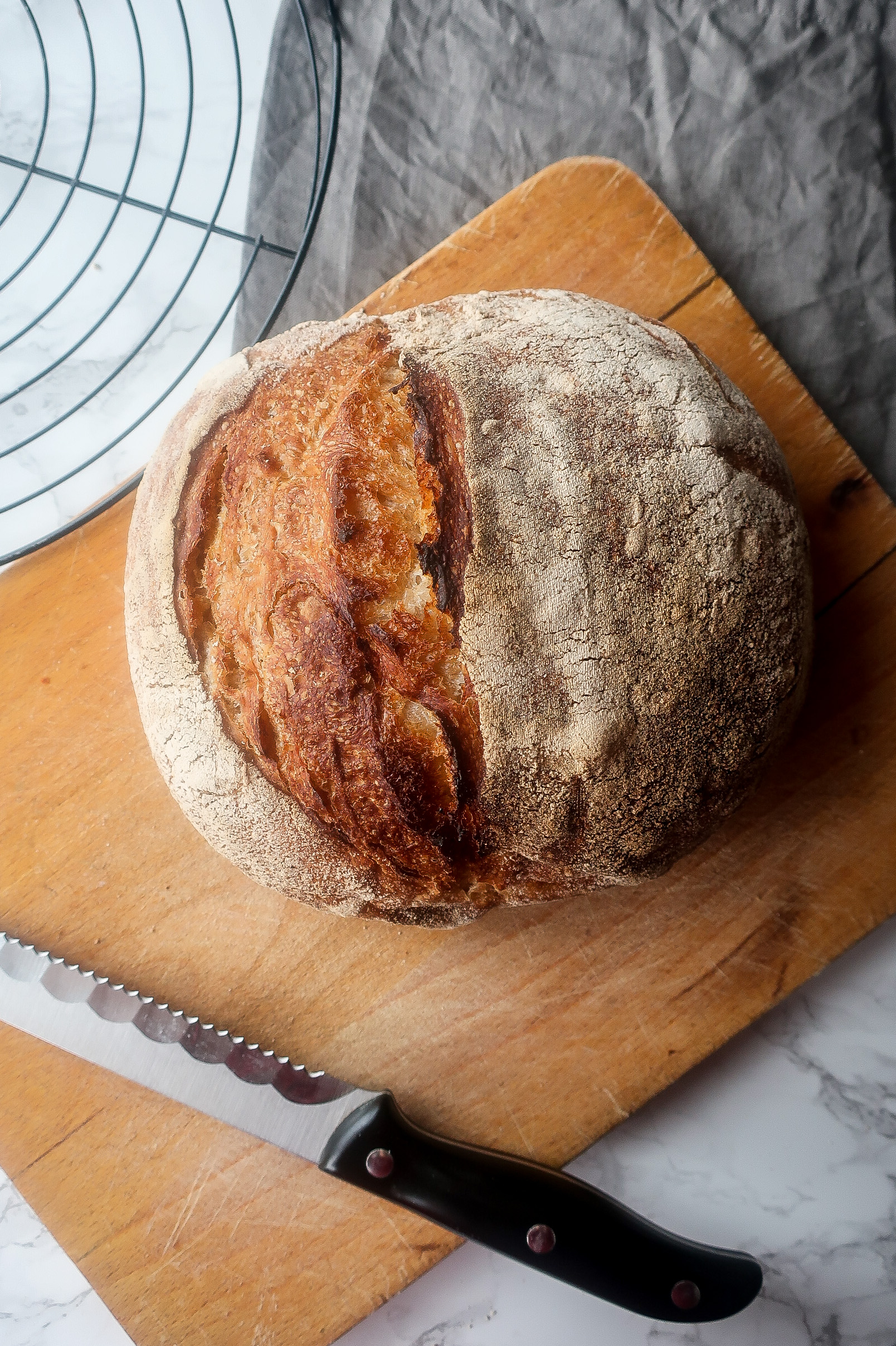
Why bake your own bread at home?
For me it's mostly fun and exciting- to make my own bread! Working with sourdough is a wonderful thing and it's very easy to fall into it. There's nothing like the smell of freshly baked bread and the gentle crackle of the crust as it cools!
What I also personally love about it is that the bread free of additives and a sourdough bread like this or just classic rolls, will last you for a week in a good condition. So you don't have to run to the store every three days for fresh bread.
Sourdough bread is basically fermented or leavened bread that uses natural wild yeast and bacteria to rise instead of using store-bought yeast. Sourdough bread is a healthier option because the fermentation breaks down phytic acid. Phytic acid is an antinutrient that blocks the absorption of nutrients found in flour. Fermentation makes these substances more absorbable to our bodies.
Why to bake bread in a pot or a Dutch oven?
Baking bread in a pot or a Dutch oven is a great way of baking bread, where the pot essentially acts as a mold for the bread. So if the dough comes out thinner than you expected, you can be sure that it won't turn into a flat bread. Which can happen when baking on a baking sheet.
Baking bread in the pot also gives you a delicious crispy crust, because the pot literally keeps the moisture under the lid for the first half of the baking process!
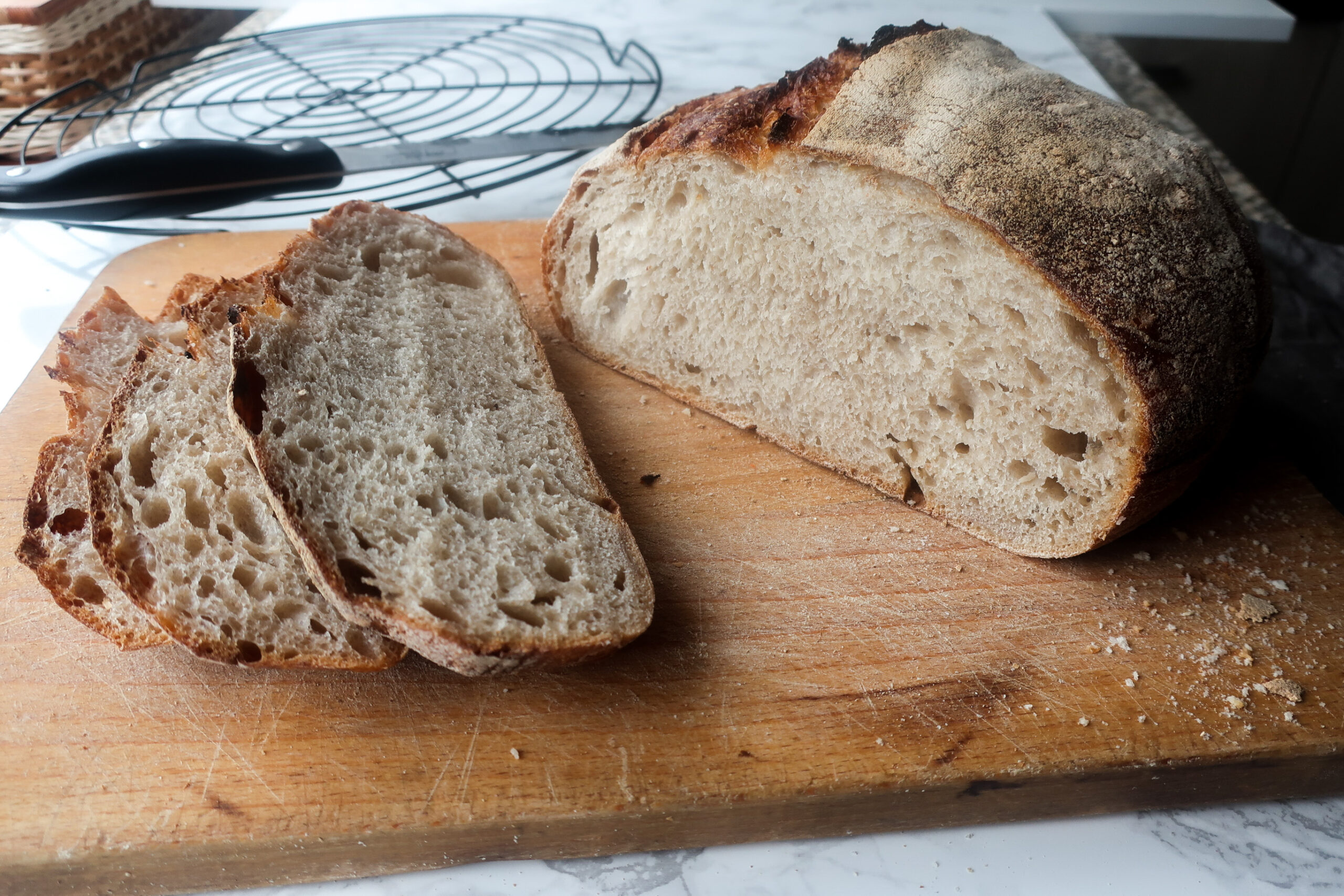
How to bake wheat and rye no-knead bread?
We have to divide the bread making process into two days.
First day in the evening , prepare the sourdough levain by mixing 75 g of wholemeal rye flour, 75 g of water and 1 tbsp (25 g) of sourdough starter. This can be rye or wheat starter. Mix well with a spoon and and cover with a plastic bag, wrap or a cling film. Let it ferment overnight at room temperature for about 10-12 hours.
If you want to know how I feed and maintain my sourdough starter, be sure to check out this article!.
The next morning , prepare 380 g of wheat bread flour in a large bowl. Alternatively, prepare a mixture of 300 g wheat bread flour and 80 g rye bread flour. Add 11 g of salt to the flour and mix with a whisk to spread the salt evenly. Add all levain . (If you need to, remove 1 tbsp of the levain into a jar and use as a starter for another baking).
Pour slowly about 250 g of water to the bowl. Add the water really little by little, because each flour varies in water content. If the dough comes out too thin, add 1-2 handfuls of wheat flour. If the dough is too stiff to form a ball, add an extra 10-20 g of water (or more, as needed).
Mix the dough with a wooden spoon or a hand. The dough should form a stiffer ball and there should be no more dry spots. Cover the bowl with a plastic bag, wrap or cling film and leave it to rise.
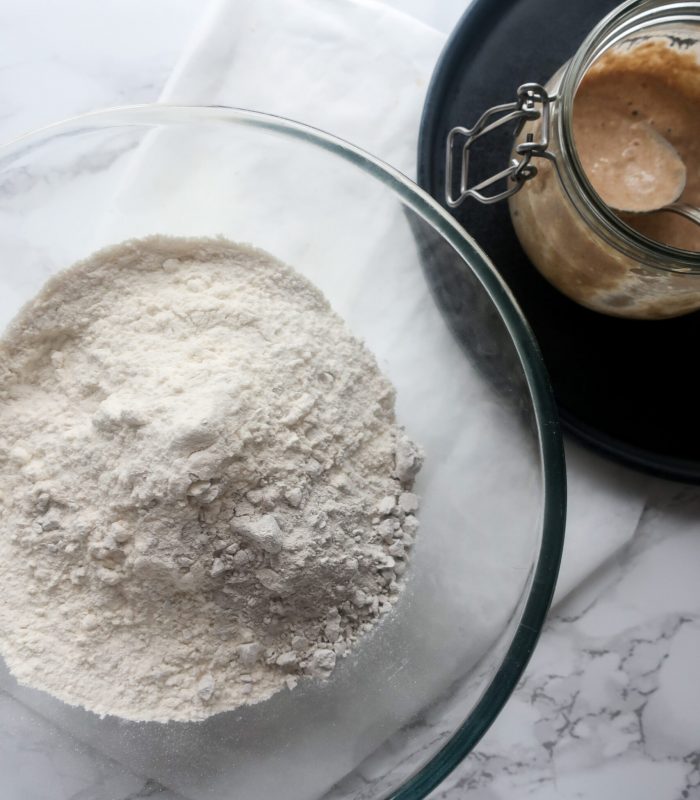
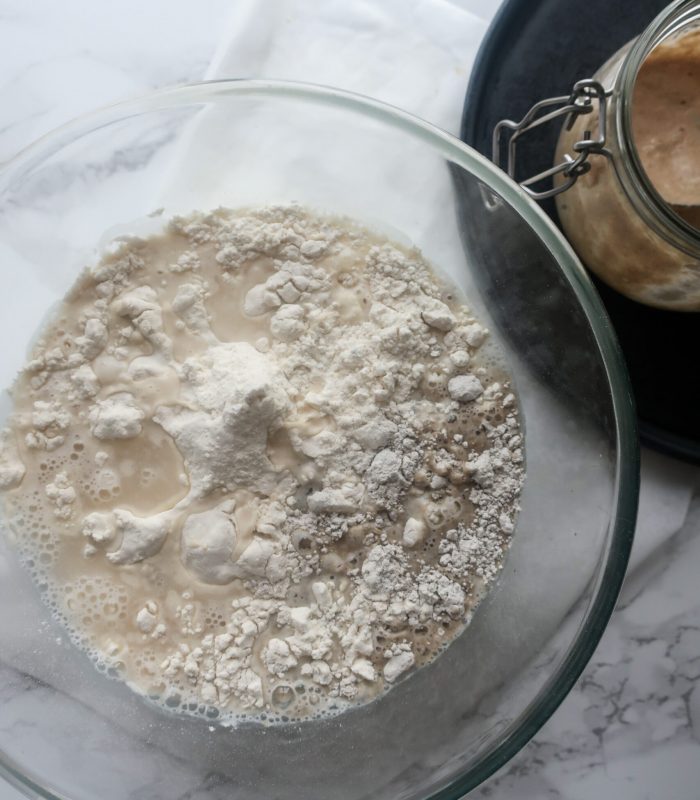
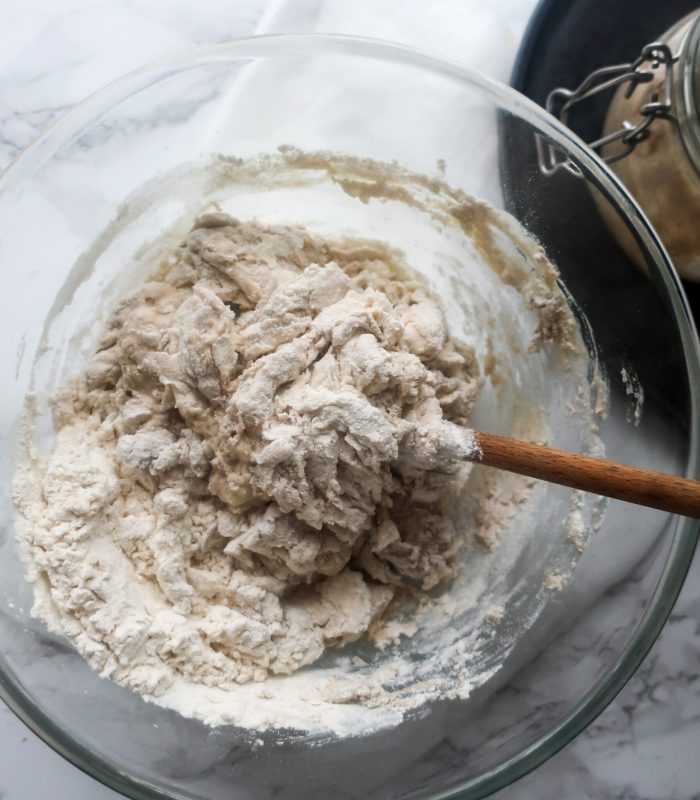
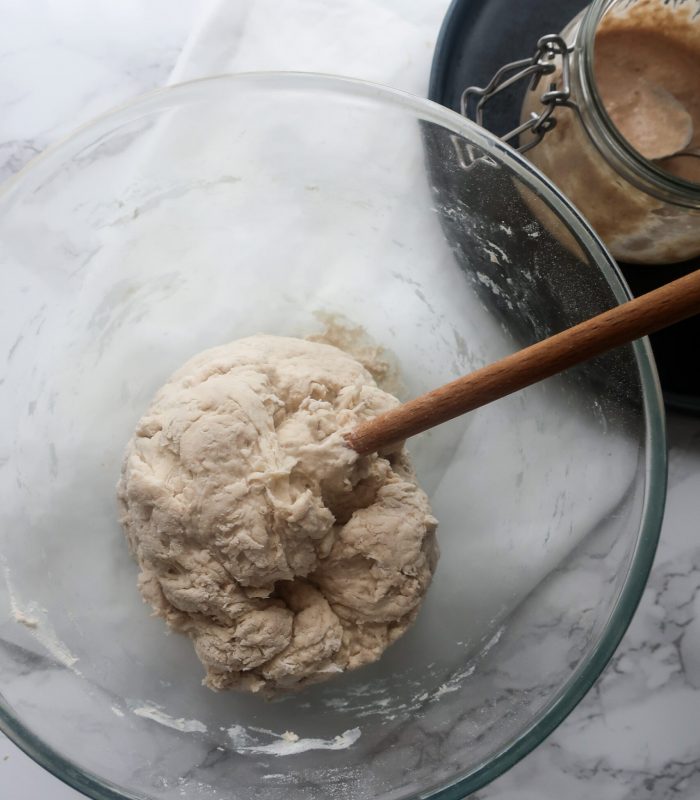
During the rising process, make 4 sets of STRETCH & FOLDS. With wet hands, grab and pull some of the dough up and then place/wrap it over the dough. Then turn the bowl and pull out another part of dough and fold over the dough again. Do this about 4 to 5 times. Then cover the bowl again and leave to rise. Each set of folding should ideally be done after half an hour.
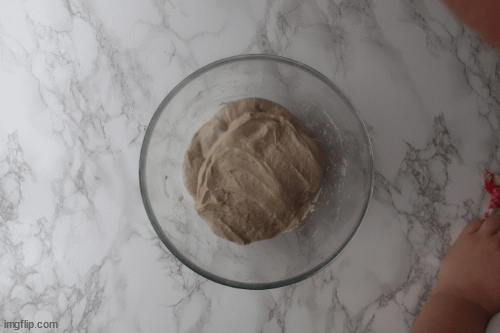
Then let the dough rise. You can tell when the dough has risen enough by the fact that it is shiny and elastic and you can clearly see large bubbles. The dough will take about 5 hours to rise, including stretching and folding. However, it depends on how warm the environment in which it rises.
Prepare a flour banneton or bowl lined with a flour clean towel. I use a 19 cm bowl and flour clean towel with wholemeal wheat flour. It's better to put more flour on banneton or towel so that the dough doesn't really stick.
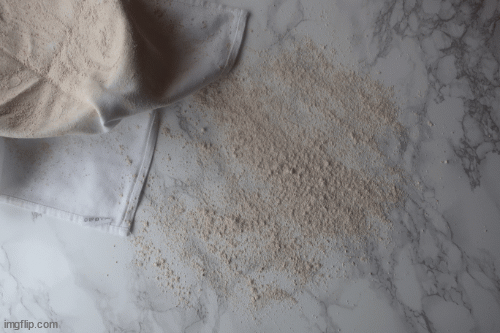
Then turn the risen dough out onto a lightly floured surface and flatten it gently. Fold the dough slowly into the center to form a ball. Turn the ball of dough with the seam facing down and begin to tighten the dough. This will ensure that the shape of the bread remains round while baking. Place the shaped dough in a prepared banneton or bowl with a towel with the seam facing up and let it rise for about 2-3 hours.
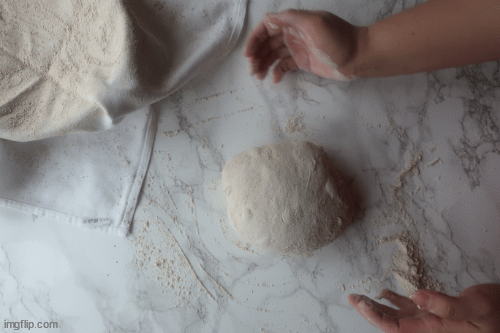
Before the dough is risen, heat the oven and a pot with a lid to 230°C. I use a 21 cm enamel pot, but a Dutch oven is also excellent for this. Make sure the pot does not have any plastic or silicone handles or other materials that cannot tolerate the high oven temperature. If you don't have a suitable pot, heat up the oven with a thicker sheet pan.
Into the heated pot turn out the risen dough . If pieces of dough stick to the towel, gently scrape them off with a knife. Be careful not to burn yourself as the pot is heated to a very high temperature.
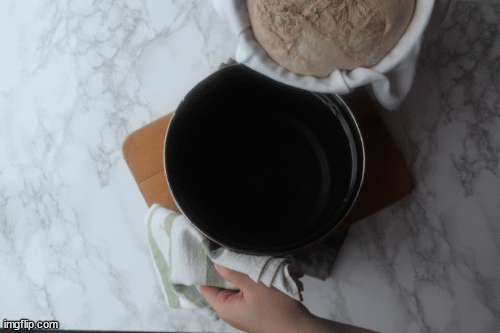
We can score the surface of the dough with either a serrated knife or a razor blade. Cover with a lid and bake in the oven at 230 °C for about 15 minutes. Then remove the lid, turn the temperature down to 210°C and bake for another 15-20 minutes.
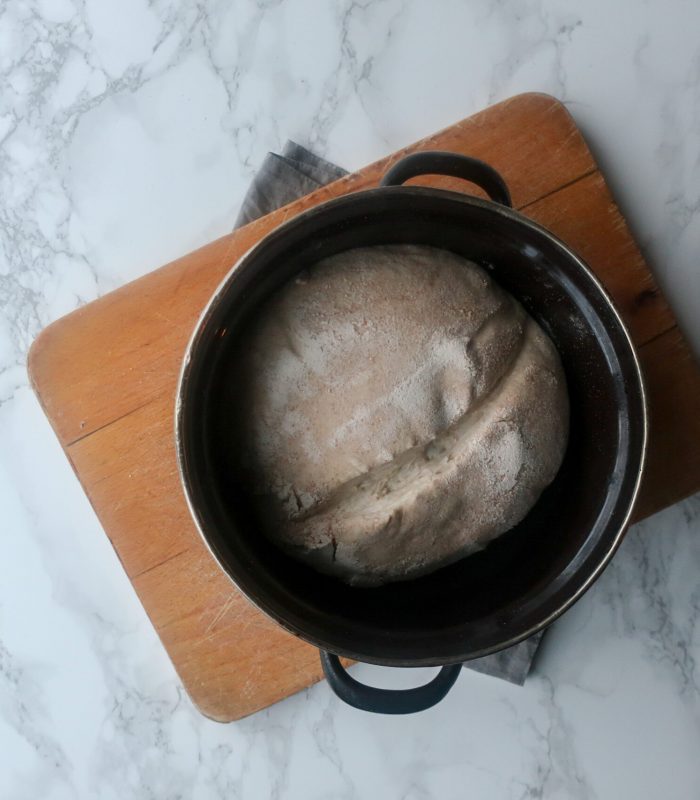
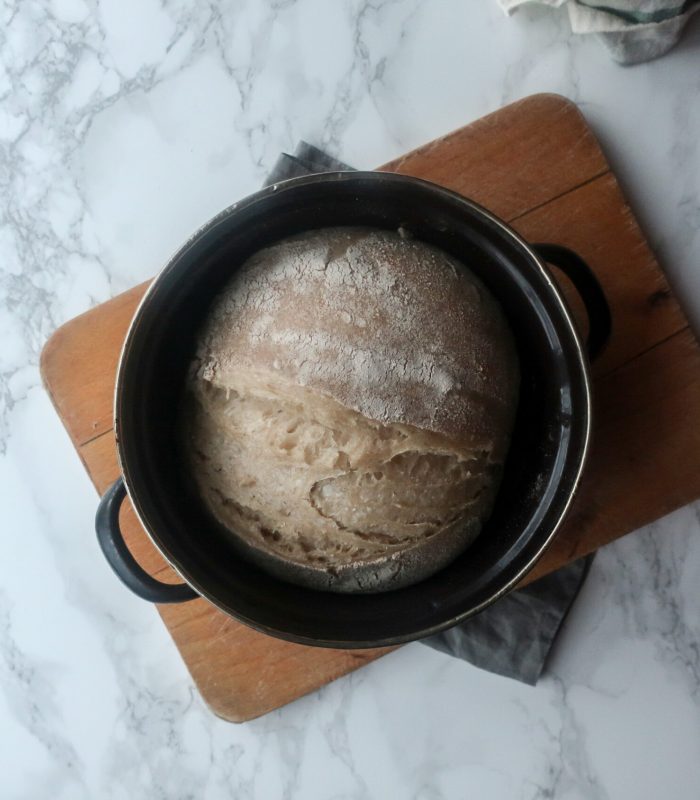
Once the bread is baked, turn out from the pot and cool on a wire rack for at least 1 hour before slicing.

How to plan the baking of wheat sourdough bread?
- First day in the evening: 20:00, prepare the sourdough levain. Let it ferment overnight at room temperature.
- The next morning: 7:00, add the rest of ingredients in a bowl and mix the dough.
- Stretch & folds: 7:30-11:00, make 4 sets of stretch and folds. Each set should ideally be done after half an hour. Then just let it rise.
- Shape the dough: 11:00, shape the dough and let it rise in a bowl with flour towel or flour banneton
- around 13:40 : preheat the oven and a pot with a lid to 230°C
- around 14:00 : the dough is risen so transfer it to a heated pot, put it in the oven to bake for 15 minutes
- 14:15: remove the lid and bake it for another 15-20 minutes at 210°C
- 14:30 the bread is baked so remove it from the pot and put it on a cooling rack
- around 15:30 : the bread is cool enough to slice and eat
Jak si upéct kváskový chléb v hrnci - upečte si se mnou!
TIPS:
- for a lighter and more airy bread, you can substitute the part of wheat bread flour for an all purpose wheat flourthen you will need to add little less water
- for a more crunchy crust , heat the oven with a pot to 250°C and bake for 15 minutes and without a lid at 230°C
- if you want a thin crust , heat the oven with a pot and bake it all the time at 210°C (even without a lid)
- you can also add a handful of seeds or nuts or bread spices to the dough while mixing
Recipe

Recipe for 1 small loaf
Wheat and rye sourdough bread (no-knead and easy)
Ingredients:
for levain:
- 75 g rye wholemeal flour
- 75 g water at room temperature
- 1 tbsp (25 g) sourdough starter (rye or wheat)
for the dough:
- whole levain (or you can add 1 tbsp of levain into a jar for the next baking)
- 380 g of wheat bread flour ( or 300 g wheat bread flour and 80 g rye bread flour)
- 11 g salt
- 250 g water, at room temperature (approximately)
- 19 cm banneton or bowl lined with a flour clean towel
- flour for dusting
- 21 cm pot with a lid, made of oven-safe material (enamel, cast iron) or thicker baking sheet
- serrated knife or razor for scoring
- wire rack
Instructions:
We have to divide the bread making process into two days.
- First day in the evening , prepare the sourdough levain by mixing 75 g of wholemeal rye flour, 75 g of water and 1 tbsp (25 g) of sourdough starter. This can be rye or wheat starter. Mix well with a spoon and and cover with a plastic bag, wrap or a cling film. Let it ferment overnight at room temperature for about 10-12 hours.
- The next morning , prepare 380 g of wheat bread flour in a large bowl. Alternatively, prepare a mixture of 300 g wheat bread flour and 80 g rye bread flour. Add 11 g of salt to the flour and mix with a whisk to spread the salt evenly. Add all levain . (If you need to, remove 1 tbsp of the levain into a jar and use as a starter for another baking).
- Pour slowly about 250 g of water to the bowl. Add the water really little by little, because each flour varies in water content. If the dough comes out too thin, add 1-2 handfuls of wheat flour. If the dough is too stiff to form a ball, add an extra 10-20 g of water (or more, as needed).
- Mix the dough with a wooden spoon or a hand. The dough should form a stiffer ball and there should be no more dry spots. Cover the bowl with a plastic bag, wrap or cling film and leave it to rise.
- During the rising process, make 4 sets of STRETCH & FOLDS. With wet hands, grab and pull some of the dough up and then place/wrap it over the dough. Then turn the bowl and pull out another part of dough and fold over the dough again. Do this about 4 to 5 times. Then cover the bowl again and leave to rise. Each set of folding should ideally be done after half an hour.
- Then let the dough rise. You can tell when the dough has risen enough by the fact that it is shiny and elastic and you can clearly see large bubbles. The dough will take about 5 hours to rise, including stretching and folding. However, it depends on how warm the environment in which it rises.
- Prepare a flour banneton or bowl lined with a clean flour towel. I use a 19 cm bowl and a clean flour towel with wholemeal wheat flour. It's better to put more flour on banneton or towel so that the dough doesn't really stick.
- Then turn the risen dough out onto a lightly floured surface and flatten it gently. Fold the dough slowly into the center to form a ball. Turn the ball of dough with the seam facing down and begin to tighten the dough. This will ensure that the shape of the bread remains round while baking. Place the shaped dough in a prepared banneton or bowl with a towel with the seam facing up and let it rise for about 2-3 hours.
- Before the dough is risen, heat the oven and a pot with a lid to 230°C. I use a 21 cm enamel pot, but a Dutch oven is also excellent for this.
- Into the heated pot turn out the risen dough from the bowl. If pieces of dough stick to the towel, gently scrape them off with a knife.
- We can score the surface of the dough with either a serrated knife or a razor blade. Cover with a lid and bake in the oven at 230 °C for about 15 minutes. Then remove the lid, turn the temperature down to 210°C and bake for another 15-20 minutes.
- Once the bread is baked, turn out from the pot and cool on a wire rack for at least 1 hour before slicing.
You may also like:
- All Post
- Back
- Breakfast
- Soups
- Breads
- Dessert
- Main dishes
- Others
- Sides

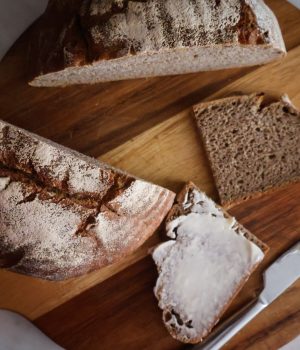
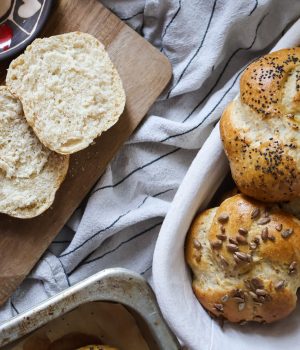
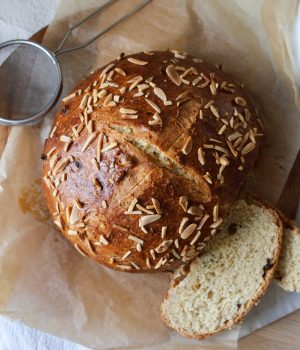
Dobrý den,
děkuji moc za inspiraci a samotný recept. Chleba jsem pekla v sobotu podle Vašeho návodu a musím říct , že se povedl a chuťově byl výborný. S kváskem jsem pekla poprvé. Jen škoda ,že nám vydržel jen do neděle . Chtěla bych upéct chleba o něco větší, ale nevím jaké množství surovin použít mohla byste mi poradit nebo napsat kolik čeho mám přidat? A ještě hledala jsem výrobu kvásku návod, ale nenašla jsem to na vašich stránkách ten můj co jsem dostala se mi zkazil můžete mi napsat návod?
Moc děkuji za odpověď
Přeji hezký den
Jana Škorvánková
Dobrý den,
jsem moc ráda, že se vám chléb daří! 🙂 Na větší chléb si můžete množství ingrediencí vynásobit dle potřeby, můžete zatím zkusit o 1/3. Pozor ale na velikost hrnce, aby vám náhodou nevybublal pod pokličkou! Já většinou, když chci tohoto chleba více, tak si zadělám na dva bochníky. Jeden chleba upeču hned a druhý dám na to druhé kynutí (tedy v ošatce) do lednice. V lednici ho nechám klidně 2-3 dny a poté peču jako obvykle. Takhle nám to vyhovuje nejvíc 🙂 Pokud budete zkoušet, tak dejte vědět, jak se povedlo!
Dobrý den,
to druhé pečení bez pokličky na 210 necháváte také horkovzduch?
Děkuji!
Ano, i dopékáni dělám na horkovzduch. 🙂
Dobrý den, teď se podle receptu snažím. Vše se mi dařilo až do posledního kynuti- překlady super a u toho posledního mi to nenakynulo nijak. Když to dáte do osatky tak to zase zalryjete folii nebo jen uterkou jako ja? Doma jsme měli 25 a vic stupňů dnes tak nevím co to. Nemohla byste mi prosím poradit?
Dobrý den, mě se teď stalo zrovna to samé 😀 Myslím, že jak se změnilo počasí, tak nám více topí radiátory. V teplejším prostředí je fermentace rychlejší, tak těsto rychle překyne při první fermentaci s překládáním a na závěrečné kynutí už nemá sílu. Zkuste zkrátit čas první fermentace nebo najděte těstu na kynutí chladnější prostředí. Přeji ať se vám další chleby vydaří. 🙂
Zdravím Ráďo, dnes jsem pekla podruhé recept na chleba z Vašich stránek, krásně se povedl…moc děkuji, za skvělé recepty. Tento blok je velmi inspirativní, vždy mám radost, když přidáte i video na youtube. Vaše fanynka Jája
Krásný den, moc děkuji za milou zprávu a jsem moc ráda, že se vám chleby daří! 🙂
Dobrý den, chlebík dle Vašeho receptu dopadl výborně. Jsem začátečník a většinou všude doporučuji dát do trouby plech s vodou, při fázi pečení bez pokličky. Vy se o tom nezmiňujete. Byl by v tom nějaký rozdíl?
Krásný den Lenko, jsem ráda, že se vám chléb daří! Pokud peču chléb v hrnci, tak plech s vodou nedávám. Stačí mi, když se chléb zapaří v první půlce pečení pod pokličkou a když se poklička odklopí, už se v podstatě dopéká jen kůrka.
Dobrý den,
můžu chleba péct v obyčejném smaltovaném pekáči? Nechce se mi hned kupovat litinový.
Dobrý den, já mám smaltovaný hrnec a funguje to v něm skvěle, takže si dokážu představit, že pokud máte takový ten klasický dvojitý pekáč, tak by to v něm mělo také fungovat 🙂
Dobrý den Radko,chtěl jsem se zeptat,jestli můžu to nakynuté těsto z ošatky ,které kynulo v lednici,hned dat do trouby,nebo se musí nechat venku,ale může hrozit překynutí.
Diky za odpověď.
Dobrý den, jasně určitě můžete. Díky studenému těstu z lednice dosáhnete i větší nadýchanosti chleba. 🙂
Dobrý den, moc děkuji za recepty a návody 🙂 Chtěla jsem se zeptat, když mám hotový kvas po 6 dnech a chtěla bych 6.den zadělat na chleba bez rozkvasu, kolik g kvasu mám do mouky na smíchání použít? Moc děkuji
Použijte 175 g aktivního kvasu
Krásný den přeji,
chtěla bych se optat, ráda bych nahradila chlebovou mouku->celozrnnou moukou. Mám si na něco dát pozor? Nemáte zkušenost, na co si případně dát pozor? Děkuji moc.
Celozrnná mouka může sát vice vody, ale je to různé od značky. Výsledný chléb ale bude určitě méně nadýchaný s menšími oky. 🙂
Krásný den! V první řadě bych ráda poděkovala za recept.🤍 Dnes zkouším poprvé a moc si přeju, aby se mi chlebík vydařil. Chtěla bych se jen zeptat, jestli si myslíte, že je vhodné tento chléb péct ve skleněné nádobě na pečení. Děkuji, krásný den!
Dobrý den, ať dělám co dělám, nikdy mi pri překládání nevychází stejná konzistence, jakou máte vy. Uz jsem chleba pekla 4x, pevně se držím instrukcí, ale těsto nikdy neni pěkně pružné, pri překládání se trhá, kdyz ho z ošatky vyklápím do formy, tak hodně splaskne a po upečení je takový hutný, má jen pár bublinek. Zkoušela jsem prodlouží/zkratit dobu kynutí, ale vzdycky vyjde stejně. Nevím, co dělám špatně. Můžete mi poradit? Děkuji.
Dobrý den, hodně záleží na typu mouky, kterou používáte. Já používám mouku Probio. 🙂
Krásný den! V první řadě bych ráda poděkovala za recept.🤍 Dnes zkouším poprvé a moc si přeju, aby se mi chlebík vydařil. Chtěla bych se jen zeptat, jestli si myslíte, že je vhodné tento chléb péct ve skleněné nádobě na pečení. Děkuji, krásný den!
Dobrý den, nikdy jsem chléb ve skleněné nádobě nepekla ale nejsem si jistá, zda zvládne tak vysokou teplotu. Raději bych jej pekla na 210, maximálně 220°C. 🙂 Dejte vědět, jestli to budete zkoušet. :))
Hezký den Radko,
prolezla jsem spoustu stránek týkajících se pečení z kvásku a ty Vaše jsou jedny z nej, díky a jen tak dál. 🙂
<3
Dobrý den,
cca před rokem jsem objevila Vaše stránky a už jiné nehledala. 👍👍👍 Zkouším různé chleby a mouky a už máme doma oblíbené recepty (bohužel tak moc, že syn “kulaté chleby” zakrojuje ještě teplé a nemají šanci vystydnout. Peču téměř každý týden. Kvásek jsem dostala od kolegy a po cca 3 měsících ho úspěšně upekla 🙈. Poté jsem dostala “puberťáka”, který jedna babička udržuje prý už 17 let a chleba se z něho v podstatě dělá sám.
Proč Vám ale píšu – přijde mi, že se mouky nějak pokazily – u nás v Albertu mají jen 2 druhy – bio a Babiččinu (tu jsem už vyškrtla – i žitný chleba byl hrozně světlý). Poradíte mi prosím nějakou vyzkoušenou? Nemám šanci si umlýt vlastní, ale mám možnost objednat (přes internet nebo Rohlík).
A druhý dotaz je na napařování. Mám parní program v troubě a používám ho i na chleba v hrnci. Jen nevím, zda to není zbytečné. Pečete i v páře? A případně co pečete?
Předem moc děkuji za odpověď.
Vaše fanynka Jindřiška
Hezký den, předně jsem ráda, že se vám pečení s mými recepty daří 🙂 S moukama je to takové, že člověk v obchodě nikdy moc neví, co vlastně kupuje. 🙂 Já mám ozkoušenou značku Probio a těch se držím! Bohužel o napařování já vůbec nic nevím, moje trouby byly vždycky takové staré babičky bez podobných funkcí 😀